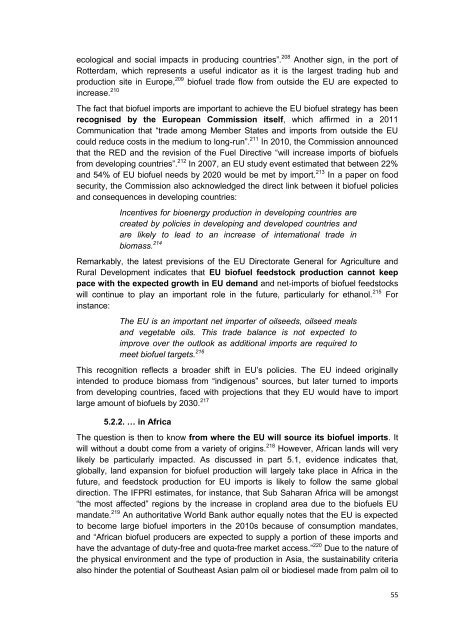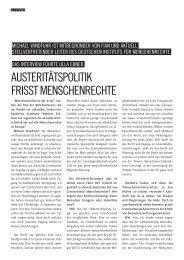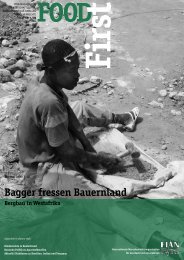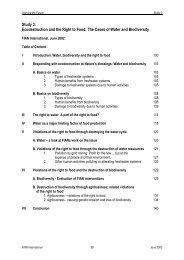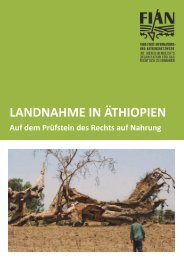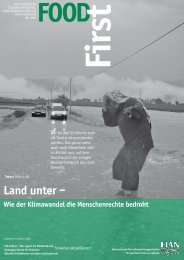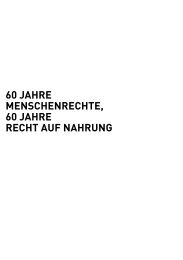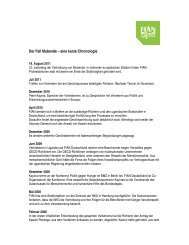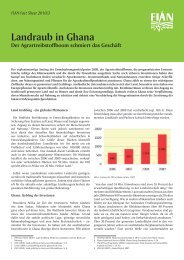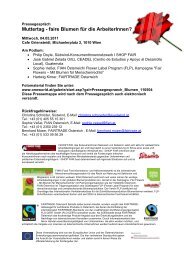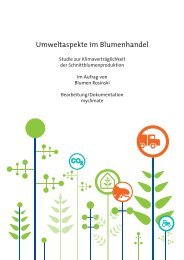(Bio)Fueling Injustice? - Europafrica
(Bio)Fueling Injustice? - Europafrica
(Bio)Fueling Injustice? - Europafrica
You also want an ePaper? Increase the reach of your titles
YUMPU automatically turns print PDFs into web optimized ePapers that Google loves.
ecological and social impacts in producing countries”. 208 Another sign, in the port of<br />
Rotterdam, which represents a useful indicator as it is the largest trading hub and<br />
production site in Europe, 209 biofuel trade flow from outside the EU are expected to<br />
increase. 210<br />
The fact that biofuel imports are important to achieve the EU biofuel strategy has been<br />
recognised by the European Commission itself, which affirmed in a 2011<br />
Communication that “trade among Member States and imports from outside the EU<br />
could reduce costs in the medium to long-run”. 211 In 2010, the Commission announced<br />
that the RED and the revision of the Fuel Directive “will increase imports of biofuels<br />
from developing countries”. 212 In 2007, an EU study event estimated that between 22%<br />
and 54% of EU biofuel needs by 2020 would be met by import. 213 In a paper on food<br />
security, the Commission also acknowledged the direct link between it biofuel policies<br />
and consequences in developing countries:<br />
Incentives for bioenergy production in developing countries are<br />
created by policies in developing and developed countries and<br />
are likely to lead to an increase of international trade in<br />
biomass. 214<br />
Remarkably, the latest previsions of the EU Directorate General for Agriculture and<br />
Rural Development indicates that EU biofuel feedstock production cannot keep<br />
pace with the expected growth in EU demand and net-imports of biofuel feedstocks<br />
will continue to play an important role in the future, particularly for ethanol. 215 For<br />
instance:<br />
The EU is an important net importer of oilseeds, oilseed meals<br />
and vegetable oils. This trade balance is not expected to<br />
improve over the outlook as additional imports are required to<br />
meet biofuel targets. 216<br />
This recognition reflects a broader shift in EU’s policies. The EU indeed originally<br />
intended to produce biomass from “indigenous” sources, but later turned to imports<br />
from developing countries, faced with projections that they EU would have to import<br />
large amount of biofuels by 2030. 217<br />
5.2.2. … in Africa<br />
The question is then to know from where the EU will source its biofuel imports. It<br />
will without a doubt come from a variety of origins. 218 However, African lands will very<br />
likely be particularly impacted. As discussed in part 5.1, evidence indicates that,<br />
globally, land expansion for biofuel production will largely take place in Africa in the<br />
future, and feedstock production for EU imports is likely to follow the same global<br />
direction. The IFPRI estimates, for instance, that Sub Saharan Africa will be amongst<br />
“the most affected” regions by the increase in cropland area due to the biofuels EU<br />
mandate. 219 An authoritative World Bank author equally notes that the EU is expected<br />
to become large biofuel importers in the 2010s because of consumption mandates,<br />
and “African biofuel producers are expected to supply a portion of these imports and<br />
have the advantage of duty-free and quota-free market access.” 220 Due to the nature of<br />
the physical environment and the type of production in Asia, the sustainability criteria<br />
also hinder the potential of Southeast Asian palm oil or biodiesel made from palm oil to<br />
55


